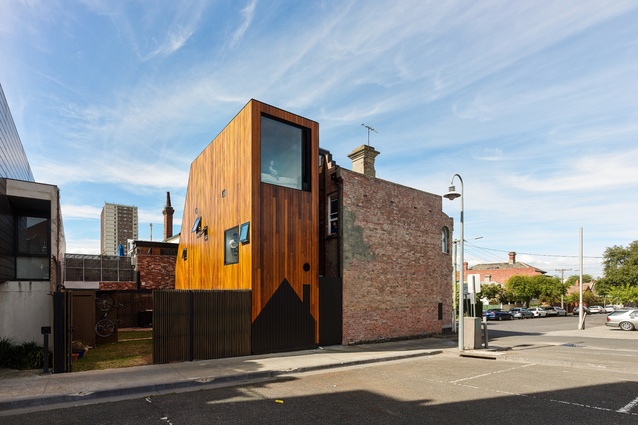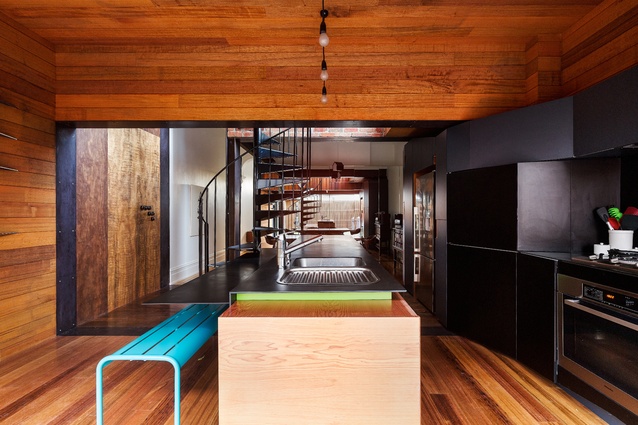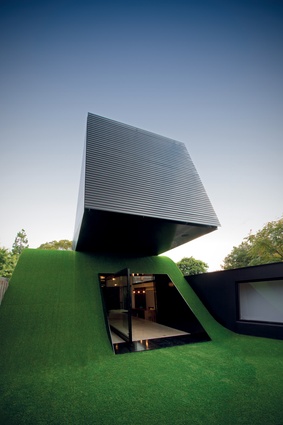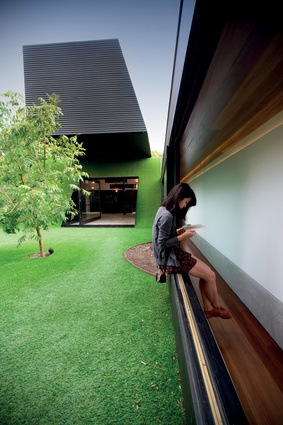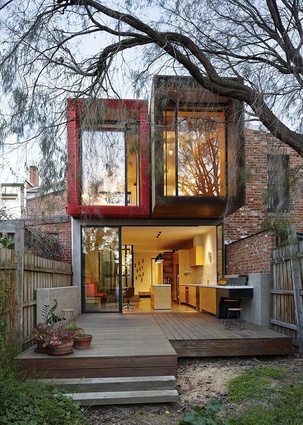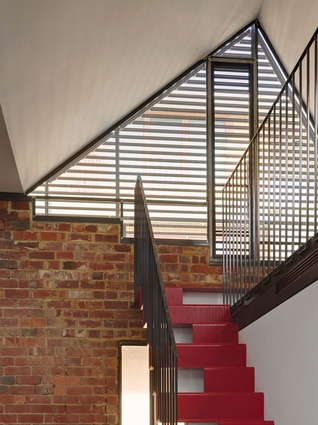Q & A: Andrew Maynard
Sam Aislabie and Natalie Bradburn interviewed Melbourne-based architect Andrew Maynard, who gave a witty and engaging talk at the 2015 NZIA in:situ conference about man-eating robots, a ‘Poop House’ and other unorthodox concepts that, for the main, also totally make sense.
Sam: You have very carefully crafted the way you practise, deliberately keeping the firm small and ensuring staff work only a set number of hours. Has this always been how you’ve worked? How did you start out your practice?
Andrew Maynard: I think I started for the same reason everyone else did: you become burnt out and cynical and think you can do better than your boss does. Like so many things in life, you just assume a trajectory – I’ll start something small, do a few renovations and then go out on my own, and that started happening. The media was talking me up a lot, which actually put a lot of pressure on me but, then, I think almost conveniently, the GFC hit when I had just started doing bigger work. It feels like we dodged a bullet because we would have had to ramp everything up. We just stopped and had a think – it became really cathartic. I came to this conclusion that the most important design task is your own life. I’m just one of those people who thinks everything is a design project – so life has just become another one.
Natalie: In your talk, you mentioned the desire to work on larger projects but also the dangers of working with developers on apartment buildings. Do you mean dangerous in terms of an end product?
AM: Financially and ethically but also the end product. In Melbourne, in order to get things through town planning, there is a trend whereby [developers] are bringing really good architects on board to design these tall towers then, as soon as they receive the planning permit, the architect is sacked for some cheaper muppets to come along and rip the soul out of it. That’s pretty dangerous because you look around and you go, “wow, the render was pretty good, now look at this piece of shit!”
Natalie: What can we do to prevent badly designed apartments? Do you think you can legislate good design?
AM: I think that legislating for the original architect to have capacity throughout the whole project is really important, so there is some authorship there. In terms of minimum sizes of apartments, I don’t have a position on that. We are allowed to do quite small apartments in Melbourne. In Sydney, you’re not allowed to, which means a socio-economic gap is being produced, which is to say “we want only wealthy people to fit in the CBD”. The problem is that so much of it has nothing to do with architects; it’s got to do with the spreadsheet. We come and tart up the façade and do a nice lobby. That’s why I’m a developer now!

Jeremy McLeod from Breathe Architecture took out all the Institute’s (RAIA) awards last year for his apartments called The Commons in Brunswick. It’s a six-storyed block, super-green and concentrated on having really low running costs. People don’t have their own air-conditioning, there are various meters that they share and the laundry is shared on the roof which means it’s a goddam party up there; there are kids everywhere and views of the city but, it’s through the pragmatics of ”I’ve got to do the laundry” that you get this amazing community space.
Jeremy came out the other side really understanding apartments from the developer’s point of view, so he bought a block over the road and brought together a handful of architects that he considered Melbourne’s ‘most ethical’ and we pulled together $2.7 million between us to build the Commons project 2.0, called ‘Nightingale’, for which he is the architect on… and, supposedly, I’m doing either 4.0 or 5.0. This project is not charity; we will make a profit out of this but it just won’t be an obscene profit where we go, “Great, I own a Porsche but I feel like an arsehole”. But we are just doing this little bit of utopia for ourselves.
Jeremy’s done the homework and the spreadsheet is there; the original Commons is oversubscribed. We could fill up five of those six-storyed apartment blocks right now in Brunswick, so what he’s doing is interviewing potential buyers and asking people to commit to the fact that they are buying their homes, not for investments and not even a place that they are going to rent out. So we are sort of taking on that whole developer model without being just utopian, naïve architects. The finances are there; it’s exciting.
Sam: Are you familiar with The Funambulist? ‘Architecture as a political act’ is the premise of this blog, which is brilliant in that, fundamentally, architecture is a violent act and The Funambulist – the tightrope walker – is the subversion of this drawing of lines by walking on the line. Boundaries and rules have a thickness. There is black and white and a million shades of grey in between. I think that you embody this literally in your projects: where you argue with local building regulations, which state “you must have a fence” but you ask “could a fence be 2m thick?” And now [the fence] is a corridor [the Hill House (2012)]. You have built something that you really shouldn’t have been allowed to. Are you playing with the rules in the same way a developer is – to your own ends?
AM: That’s something I’m really interested in because so much of what we (architects) do is dictated by others. There’s a really important book that is boring and hard to read called Social Syntax by Professor Bill Hillier and he’s approached space almost mathematically. He calculates the layers and gives a number to how deep the syntax goes: the layering. He’ll take a wall and say “well, that’s ‘zero’”; you come against it and it says, “get fucked” (claps hands), then you put a window in it or an opening and now it’s ‘three’. But, if you put a door in it, it goes back to ‘two’ because that suggests control. You don’t just walk into a room, there is a level of control.
One of my former teachers at university applied all of this to the palace of the Forbidden City in Beijing, which is really interesting because the further you go [into the building], the more important you must be and, of course, the guy in the centre knows everything happening in each layer. So, it’s using space forever; space is being used as a point of power and control. I think, we need to think about that more than ever now. When you look at institutions of power, like Parliament House [Melbourne], for example, and the steps going straight down to Bourke Street, then you can see along it; these are really democratic but then there are cops wandering along and you try to get into the building… well, it’s an illusion of democracy.
Then, you think about the world we are operating in, that’s run not by government but by corporations and the levels of control that are invisible. I don’t know what architects can do about it but, I think, we really need to know what we are doing because we are being asked to do some stuff that is questionable, even in workplaces. I mentioned that briefly in my essay on workplace equity (archiparlour.org): that thing of pretending to do these really warm and friendly places – break-out spaces and all that kind of stuff – they are fucking hostile places! There is so much control happening there and it’s mental control; it’s terrifying.
Sam: You mentioned that you have an aspiration for a 50:50 split between polemic work and commissioned work. Do you ever come close to achieving this?
AM: Oh, it doesn’t happen. When I first started, it was almost easy because I didn’t have much to do; I just had two projects and they were both sitting in town planning. But that has pretty quickly become impossible to do. I like putting it up as a slide, not to say ‘this is what we do – how cool’ but just to say that this was the premise. How much do we get to do? Not many, a couple a year. I was trying to work it so that competitions of some sort would trigger them – that’s a whole different rant about how we shouldn’t be doing free competitions – anyway, it’s really hard to do; wherever there is a possibility, we try but it’s harder than ever. But the good thing about how we’ve set up AMA [Andrew Maynard Architects]: Mark [Austin, his co-Director] is the real ‘how’ guy; I’m more of a ‘why’ guy. It means that, if I ever want to go escape and play with something, knowing the projects are still going, I can.
Sam: I’m curious about the life of your paper projects. Are they just exercises for yourself or they intended to be published as polemics?
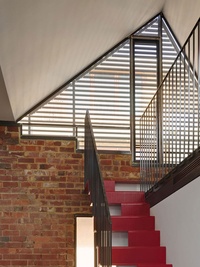
AM: The Styx Valley Protest Shelter was deliberately a propaganda device and we weren’t going to tell anyone that we weren’t going to build it until it received shit-loads of press. It worked for the Woodland Society and it really worked for me in terms of, “Hey, maybe that architect is interesting”. I’m not going to pretend that it’s all for charity. It’s the same as Nightingale; we are doing really good important stuff but I’m still going to make money out of it because that’s the sensible thing to do. That’s how you make these things keep going. If you do all this charity, eventually you get burnt out; you have to make sure that you are actually getting something out of it as well.
Sam: Do you intend for these polemic projects to be for a public rather than an architectural audience?
AM: I’m definitely interested in media in general: ‘us’ being able to talk as an industry to the public, which we really haven’t done for a generation. The office makes sure that we try to speak clearly about things so that the layperson can understand. We try to think about the general public with everything that we do.
Sam: AMA is made up of two directors, yourself and Mark, how do you design together?
AM: We all just make it up as we go along. Design is really hard. The guy I’m always referring to is Leonard Cohen because, when he talks about writing music, he says it’s not inspiration. And what the hell is creativity? It’s absolute labour; it’s nine-to-five labour. To write one good song, you’ve got to do 10 shit songs and then throw them out, and that’s exactly how I work. You start with the stock-standard response and then you have to be totally willing to throw it all away.
But what you are doing is: you’re excavating, you’re mining, trying to find the little bits of gold that can hopefully turn into something really good. And when you find them, you also have to be ready if that bit of gold actually goes somewhere else; it’s not related to the project anymore – you gotta throw it away and you’ve just gotta keep on knocking away at it.
A full list of the speakers who attended the NZIA in:situ conference here.

